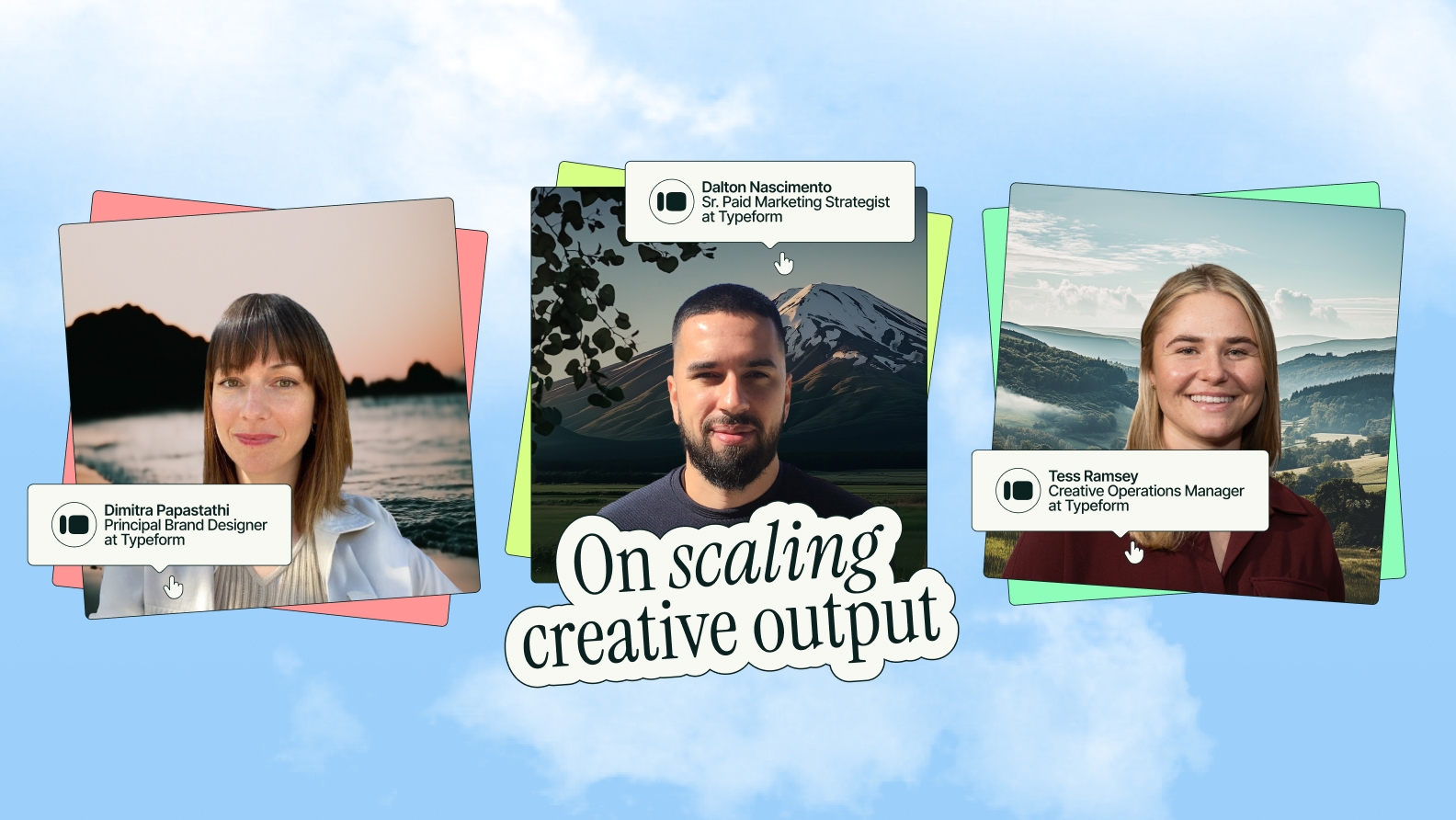
Tired of having great ideas squashed at the eleventh hour? See how Twilio's creative-marketing duo Adam Morgan and Nicholas Kontopoulos build the trust, relationships and excitement needed to get company-wide buy-in—and goosebump-worthy results.
A creative vision can’t fly without buy-in—no matter how bold, inspired or strategic it is.
Because without leadership buy-in, key initiatives from rebrands to quarterly campaigns become drawn-out, diluted affairs. And without buy-in from in-region representatives, even the best brand narratives will lack impact.
But between Twilio’s Adam Morgan, VP of Brand, and Nicholas Kontopoulos, VP of Marketing, Asia Pacific & Japan, they’ve got it covered.
Morgan and Kontopoulos broke down their approach to proving success and getting buy-in across the business in our latest guide, Inside Great Creative Partnerships. From masterful storytelling to a powerful brand-to-revenue model, they shared:
- How to communicate a creative vision upwards and downwards
- Which quantitative, qualitative and distinctive success metrics to consider
- What narrative to focus on for performance vs. brand marketing leaders
- How to tie storytelling to tangible business outcomes
- When to push a creative idea and when to pull back
- Why buy-in is really all about relationships
And it all starts with a deep understanding of their internal audience…
Making creativity make sense
On Morgan’s end, he literally wrote the book on proving the value of creativity to the C-suite. His short answer: “It all depends on what type of person they are, and what they believe in currently.”
He added the caveat of knowing your moment: “The best time to do it is not when there’s heat. Whenever there’s heat, they’re going to say just show me the numbers.”
Given a reasonably temperate environment, Morgan’s practical next step is putting together a presentation for his specific audience in leadership and walking them through the vision. At the end of the day, his goal is, “to share enough emotion that they feel something and they’re in on it.”
The reality is, if they don’t know, they’re going to be worried, and that’s when they’re going to push and probe and ask questions and not trust it. When you say educating them, it’s about building trust and proving to them you’ve got this. You’ve got a vision. You’ve got a good plan.

Kontopoulos then ensures Morgan’s vision gets translated into a story that connects with marketing and sales representatives in region, as well as with regional audiences’ themselves. Having started his career in sales, Kontopoulos excels at understanding both sides of his internal audience, speaking in the quantitative and qualitative terms these parties resonate with.
Part of what we try to do is take Adam’s story and translate that in terms of what it means for us in region and ultimately how it flows into the market, ensuring there’s a red thread running all the way back to that meta story, which we want to tell.

Quantitative, qualitative and distinctive success metrics
So, leadership is bought-in on your creative vision—but how do you prove the impact of that vision and ensure the continued, long-term support brand narratives require to truly succeed?
Kontopoulos spoke to tracking a tapestry of signals, which inform a compelling brand-to-revenue, go-to-market model. In plain English, “How do we tell our story in the market and track that all the way through to booked-won revenue.” He explained that his team is set up to think in that context, encompassing everything from comms and PR to field events.
In quantitative terms, that might include tracking branded keywords, engagement and conversions: Has a creative initiative or campaign led to any measurable uplift?
In speaking to qualitative signals, Kontopoulos lit up, sharing a recent example from a conference in Bangalore. From the keynote to breakout sessions, the booth experience all the way to post-event engagements, Kontopoulos explained how they’d unleashed Morgan’s new brand toolkit with the aim of connecting with the developer community. What gave him goosebumps:
We had folks coming up to our booth saying, wow, love your new branding, it really connects with us. And this is the developer community, the very audience we wanted.

But that qualitative feeling, that buzz, isn’t limited to target audiences or customers. Kontopoulos stressed the importance of how internal teams, from marketing leadership to the sales organization, are feeling and how excitement and buy-in leads to greater employee engagement and results.
Morgan shared a similar experience from Twilio’s recent SIGNAL event in San Francisco. The sales team reported back that big customers sensed a change of feeling—an energy, or in modern parlance, a vibe that the Twilio brand is alive and thriving. The very real impact: Increased deal sizes across all of their sales.
When you hear that, it’s like yeah, it does trickle to sales. And sales is a good indicator. When things are going up and people are feeling it, then the creative’s working.

Morgan pointed to similar quantitative metrics as Kontopoulos, explaining how on a day-to-day basis he looks to branded search and engagement scores, including how many actions audience members are taking once they’re in the Twilio ecosystem. At a higher level, he conducts a brand perception study once a year.
But it was Morgan’s turn to light up when speaking to another, more intangible measurement: Distinctive assets.
In a recent John Lombardo podcast, Morgan recalled hearing the term “distinctive assets,” described as elements unique to a brand that bring higher value than just day-to-day metrics. Think the shape of Coca-Cola’s bottle or their polar bears. A lightbulb moment for Morgan, he believes in building long-term support by thinking bigger than the obvious or tangible measurements and asking yourself, “What distinctive assets can I create that will give us brand value beyond the small metrics?”
Walking the tightrope of performance and brand marketing
If you’re lucky, you might have a CMO like Morgan and Kontopoulos do at Twilio—a leader who understands both brand and performance marketing.
In a role like Morgan’s, that means his CMO, Chris Koehler, doesn’t want to look at a thousand metrics. He’d rather be briefed on the big picture: Two to three key brand metrics. But if a CMO slants more towards performance marketing, you might need to bring in more of those smaller, day-to-day metrics to prove out the value of creative initiatives and campaigns. Again, Morgan stresses the importance of knowing your internal audience when it comes to presenting qualitative and quantitative metrics and getting that all-important buy-in.
Kontopoulos reflected that for a long time, “the SaaS industry overindexed on performance marketing and lost sight of the value and critical nature of investing in brand.” But now, both he and Morgan are seeing the pendulum swing back towards brand, signaling a renaissance of sorts—a revival of creativity and longer-tail strategic thinking.
Tying storytelling to outcomes
Of course, in B2B marketing, sales still drives a lot of the energy. That’s why Kontopoulos emphasizes the importance of internal education. For him, it all comes back to storytelling and translating that story to sales stakeholders.
In its simplest form, that means tying creative initiatives to pipeline and revenue. Kontopoulos explained these numbers, “help them understand the importance of storytelling and how that enables us to widen the conversation we’re having with customers and connect with all the different audiences we need to engage with.”
In other words, getting buy-in downstream is equally important for driving business results—and this is where his collaboration with Morgan plays a critical role:
Having someone like Adam that can bring brand into focus in a much crisper, clearer way, enables us to also translate that into the love language of sales in the field.

A storyteller at his core, Morgan takes a similar approach selling ideas upwards, likening it to how you’d present “the story to the street.” How does that play out? To paint a full picture to leadership, try outlining:
- What’s coming?
- What you’re going after.
- What you’re going to change to get there.
We have to set it up for leadership, rather than just asking them, ‘Hey, what do you think?’

Knowing when to push and when to pull back
Even the best storytellers, the keenest audience observers, will encounter resistance to their ideas on occasion. In these moments, a judgement call comes into play: Whether to push or pull back.
There are times when you read the room, you make an assessment and you go, okay, I’m going to park that one for now. But there are times when you hold your line and you push forward.

When holding the line, Kontopoulos specified it’s helpful to have established trust. He shared the example of a creative direct mail campaign he built targeting key retail accounts in Australia where they sent a safe full of goodies to these accounts, and if they couldn’t crack the code, they’d have to chat with an account executive to get it. The concept was novel to the region—and was met with skepticism by the market’s sales leader.
Having established trust and proven out this strategy in previous roles, Kontopoulos felt confident holding the line. Ultimately, the sales leader agreed, abiding by Twilio’s marketing ethos of nothing ventured, nothing gained. “He trusted me on it, and it turned into one of our most successful direct mailer campaigns. We had customers literally ringing us saying, put us out of our misery. We can’t crack this code. It was like a 44% conversion rate in terms of getting into sales meetings,” Kontopoulos shared.
When met with skepticism, Morgan suggested another approach is to start small: “Try a little media blitz or a social media pilot, then get the trust and go all in.”
But there are also times when pulling back completely is the right move. In Morgan’s experience, once there’s negativity around an idea, it can be difficult to turn the tides. Instead of fighting the direction of that tide, coming up with a new idea can prevent a situation from souring. “There’s an endless well of good ideas,” said Morgan. Plus, taking feedback and reaching back into the well from time to time shows humility and a collaborative spirit.
Build relationships to get buy-in
“Wear the customers’ shoes” is one of Twilio’s values.
Kontopoulos applies it to his internal customers, too. A large part of his success stems from a deep understanding of stakeholders across marketing and sales: The problems they face and the root cause of those issues.
By demonstrating not only how brand ties back to revenue, but how creative solutions address stakeholder problems, Kontopoulos builds the trust and relationships he needs to execute in the highly integrated manner essential to drive impact at a global organization.
Meanwhile, Morgan enables that revenue-driving work by creating a story both leadership and their audience can connect with: One that speaks not just to symptoms, but to root causes as well.
Together, Kontopoulos and Morgan navigate internal storytelling, ensuring conversations about impact are informed by an understanding of long-tail brand strategy—building relationships across the business, trust from top to bottom and confidence in the power of creative.
Education is really important to see the longer tail of what we do. Marketing is a four rolling quarter engine. Our ability to move the needle in quarter is minimal. Sales is engineered to think current quarter plus one at most. There’s a tension there that we’re always having to navigate. At the leadership level, it’s a similar problem.

Combine superpowers to command impact
At Twilio, Morgan and Kontopoulos combine their storytelling superpowers with a deep understanding of their internal audiences to not just get buy-in, but build genuine buzz, leading to goosebump-worthy results.
Just another example of how great things happen when creatives and marketers align. Because united we bring together creativity and empiricism. Resonance and results. The big ideas and the bottom line.
For more lessons on alignment, collaboration and creativity with impact, be sure to check out our full guide, Inside Great Creative Partnerships.














